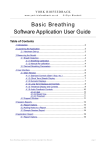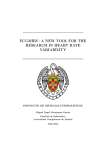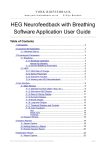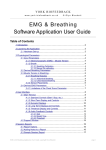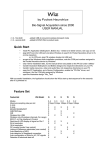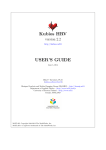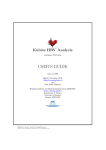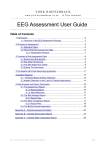Download Heart Rate Data Collection Software Application User Guide
Transcript
YORK BIOFEEDBACK w w w. yo r k - b io f e e d b a c k . co . u k © Glyn Blackett Heart Rate Data Collection Software Application User Guide Table of Contents 1 Introduction.......................................................................................................1 2 Launching the Application.................................................................................2 2.1 Hardware Set-up...................................................................................2 3 Physiological Parameters..................................................................................3 4 User Interface...................................................................................................3 4.1 Standard Controls (Start / Stop, etc.)....................................................3 4.2 Heart Rate Display and Controls...........................................................4 4.3 Heart Rate Calibration Displays............................................................4 4.4 Recording Data.....................................................................................5 4.5 Spectral Analysis Display......................................................................6 1 Introduction This guide introduces the Heart Rate Data Collection application, part of York Biofeedback's MindBody Training Tools suite. This set of applications is designed to develop skills in mind-body awareness and self-regulation, particularly in a context of mindfulness and meditation practice. This guide shows you how to use the application. The Heart Rate Data Collection application was not designed as a biofeedback application (though it can be used for simple visual feedback). Rather it's purpose is simply to record heart rate data for use with third party analysis software. An example of such a software is Kubios HRV, developed by the University of Eastern Finland. The guide assumes that you have read the Software Installation and Set-up Guide, and therefore know how to start the application. The user interface is covered in section 4. When you start the application, you can first make sure that you are accurately detecting heart beats, then you initiate a timed period during which data is recorded to a text file for later analysis. The application works with several devices. For an up to date list of supported hardware, please see the York Biofeedback website. Some of these devices use a PPG sensor to detect heart rate, others use ECG – the software works with both modalities. Heart Rate Data Collection Application User Guide, copyright Glyn Blackett page 1 2 Launching the Application 1 Figure 1 – Heart Rate Variability Tab of the Platform Application Figure 1 above shows the Heart Rate Variability tab of the Platform application. Press the button labelled 1 to launch the HR data collection application. Make sure you have your BioEra licence key (dongle) inserted into a USB socket. After a few seconds two new windows will appear on your screen. 2.1 Hardware Set-up The physical aspects of hardware set-up (how to connect and use your sensors, etc.) are dependent upon the type of amplifier you are using, and are covered in a separate document (Hardware Set-up Guide). Before you start the application you configure the Device set-up options, accessible by clicking a button in the Set-up tab of the Platform. In the dialog, select the type of amplifier (biofeedback device) you are using, in the HR source control. In the same dialog you should select the frequency of your local mains (e.g. 50Hz in the UK). All the source settings are remembered the next time you start the Platform. See the Installation and Set-up Guide for further details of device set-up. Figure 2 – amplifier status One of the device options is 'Simulator'. In simulator mode, you can learn how to use the software without the encumbrance of sensors, leads etc. (The application simply uses recorded data as a source.) Once you have started the application, you should see your device selection reflected in the device status display in the top right corner of the main window (see figure 2). The lamp (shown as a red square in figure 2) should change to green when you press the play button. If you do not see this happen, it means that the application has not been able to establish a connection with your device. Check it is plugged in and that the batteries are not flat. For some devices, you'll see a button rather than just text. Pressing this button opens up a dialog Heart Rate Data Collection Application User Guide, copyright Glyn Blackett page 2 that allows you to adjust settings related to the device, such as COM port. The specifics depend on the device – see the Hardware Set-up Guide for more details. 3 Physiological Parameters Heart rate data is derived from either ECG or photoplethysmograph (PPG) signal, depending on the device type selected (see device set-up options on the set-up tab of the launcher). In either case the “raw” signal is displayed in the user interface – see figure 5 below. The heart beat detection algorithm uses a threshold, which is shown as a dotted yellow line in figure 5. See section 4.1.3 below for more on heart rate calibration. Figure 5 shows an ECG signal. In the case of PPG the “raw” signal displayed is actually the first derivative of the PPG signal (used because beat detection is more reliable). 4 User Interface This section explains the charts in the application's user interface, and how to use the controls. Figure 3 below shows the application's window. 1. Standard Controls 2. Heart Rate Display 8. Raw ECG Display 3. Spectral Analysis Display 7. Beat Detection Display 6. Heart Rate Numeric Displays 4. Data Recording Controls 5. Beat Detection Threshold Control Figure 3 – User Interface 4.1 Standard Controls (Start / Stop, etc.) A set of buttons – Play, Stop and Pause – are labelled 1 in figure 3 above. The same in all the applications in the suite, they should be self-explanatory. Heart Rate Data Collection Application User Guide, copyright Glyn Blackett page 3 4.2 Heart Rate Display and Controls 1 2 3 Figure 4 – Heart rate display and controls The chart shows heart rate in red. It has three associated controls (1 to 3 in figure 4): Period This controls the length of time it takes for the trace to traverse the whole chart from right to left – or in other words the horizontal range. HR Range Controls the difference between the upper and lower limits of the Heart Rate display (red trace, upper chart). Change this if the HR trace looks too bunched up or stretched out vertically. Centre HR This button is used to centre the red heart rate trace to the middle of the chart – i.e. it causes the trace to be shifted either up or down (but without changing the scale). Trace You can use this if the trace is disappearing off the top or bottom of the chart. The (Button) trace is automatically centred during the first minute of the session. Heart rate and average heart rate are shown in numeric displays (6 in figure 1). 4.3 Heart Rate Calibration Displays 1 Figure 5 – Heart rate calibration displays In figure 5 above, the upper chart shows raw ECG signal from which heart rate is computed. The yellow dotted line shows the threshold for beat detection: each time the sharp upward spike crosses Heart Rate Data Collection Application User Guide, copyright Glyn Blackett page 4 the dotted line a beat is detected. If you're using a PPG-based device this trace will look different, but the same concept applies – the yellow dotted line indicates the beat detection threshold. The combo box control 'Threshold Level' (labelled 1 in figure 1) can be used to fine-tune the threshold level, moving it higher or lower so as to give the most reliable beat detection. The lower chart shows beat detection in a digitised form. Note that some basic artefact exclusion methods have been applied. 4.4 Recording Data 1 2 3 4 5 Figure 6 – Data recording controls The application writes HR data to a simple text file, which can be saved for analysis. The data written is simply a series of consecutive inter-beat intervals measured in milliseconds. Data is written for a timed period. You can set the length of this period using the combo box control 2 in figure 6 above. Once you are assured that you have an adequate signal, press button 4 (figure 6) to start recording. The 'Lead Time' control (1 in figure 6) allows you to set a short period before recording – this is for when you're recording yourself and need a few seconds to become still after pressing the button. A numeric display (3in figure 6) shows your progress through the timed period, and another numeric display (6 in figure 1) shows each inter-beat interval. At the end of the timed period the application automatically switches off. You can then give a name for your data file, which will be saved in the user data location (see the Installation and Set-up Guide for details. Heart Rate Data Collection Application User Guide, copyright Glyn Blackett page 5 4.5 Spectral Analysis Display 1 Figure 7 – Spectral analysis chart This chart displays the results of spectral analysis of the inter-beat interval data. The meaning of spectral analysis is rather technical and is described at greater length in the HRV Application User Guide. It is included here to give you an impression of the degree of coherence. Good coherence looks like a single clear strong peak in the green segment with other segments being relatively flat. The numeric displays show the percentage of the total power within each of the three frequency bands (VLF, LF and HF), and additionally the LF to HF ratio. There is one control associated with the chart (1 in figure 7). DFT Samples This combo box controls the number of data points (IBI) used for the spectral analysis. In effect this controls the size of the time window over which the spectral analysis is calculated. Assuming an average heart rate, a setting of 256 gives a window of around 3.5 minutes. Heart Rate Data Collection Application User Guide, copyright Glyn Blackett page 6






